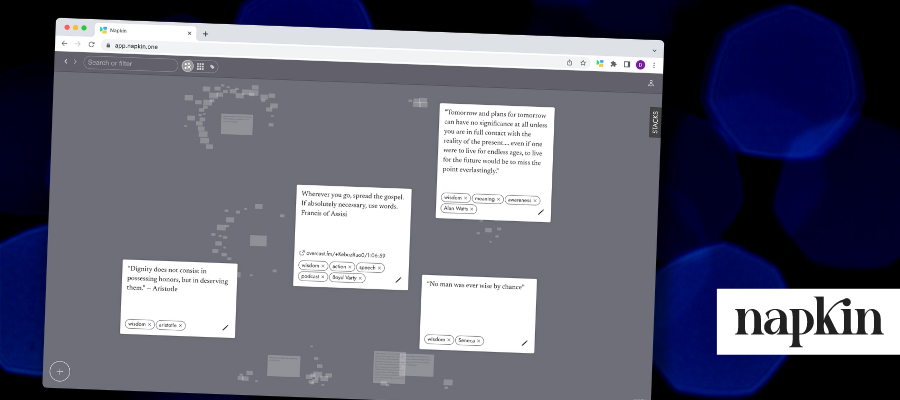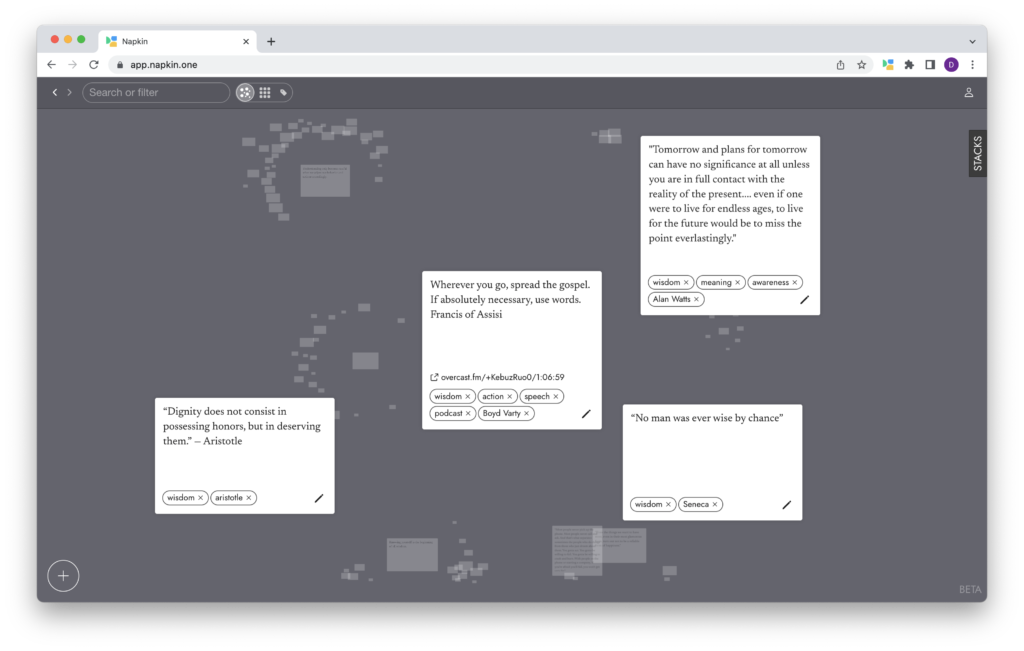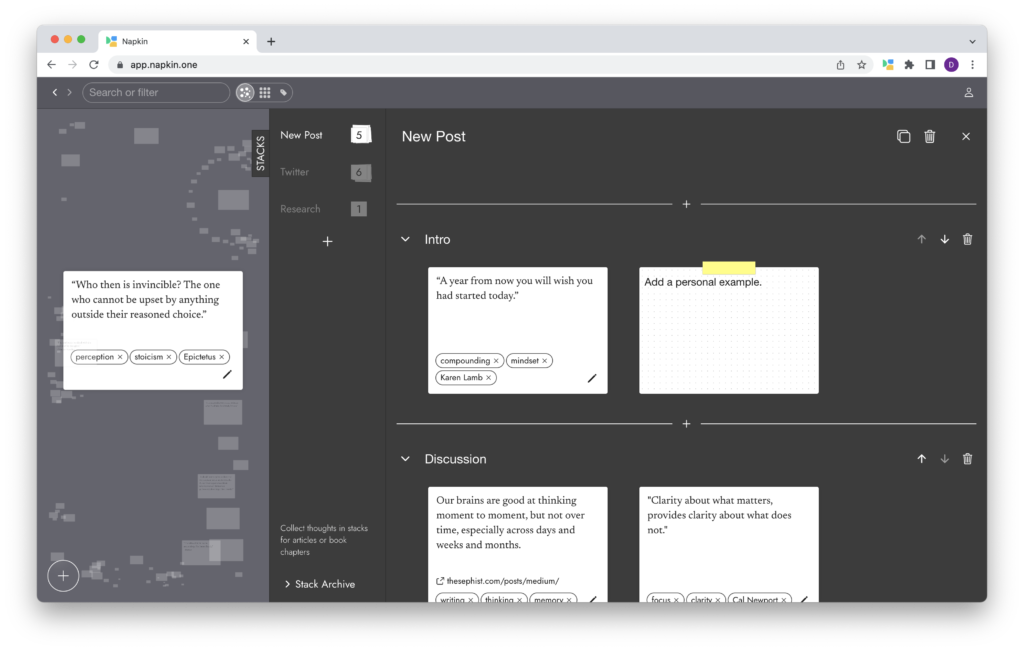
As a creator, I live at the intersection of note-taking and visual thinking tools. I love how note-taking tools enable me to capture my notes quickly and nurture them over time. But, distressingly, my ideas are stored in long, linear lists of “note cards.” It’s hard to group related ideas together and “connect the dots” between them.
Napkin, a new visual note-taking app, aims to solve that problem by placing notes within a visual canvas. It also adds AI to the mix, suggesting connections between notes. This takes visual serendipity to whole new level!
I was so intrigued by what I learned about Napkin that I reached out to co-founder Fabian Wittel to discover the thinking behind it, how it helps creators leverage their ideas and what’s next.
Chuck Frey: What inspired you to create Napkin?
Fabian Wittel: We dreamed of a thinking companion that helps us to joyfully explore connections between the most important ideas we come across. A simple and beautiful system that helps us to stay sane and focused in this wild world.
Frey: Isn’t that possible with existing tools? What needs weren’t being met by existing tools that made you realize you needed to create an application like Napkin?
Wittel: We spent years trying all kinds of apps – and there’s great progress in that market! However, all the tools we found forced us in static structures. They allow me to create connections and backlinks between notes. Still, if I don’t come up with the connection myself, it stays hidden. And, most important: they all felt like “work” to us. We want a tool that allows us to play with our notes.

Frey: How, specifically, does Napkin help users capture and develop their ideas?
Wittel: You can send any short text to your Napkin with a web clipper or your iPhone. Napkin will create a note for each text and suggest topics the note is connected to. To develop ideas you browse your notes in Napkin’s “swarm interface” and explore connections between them. One of our fans called Napkin his “inspiration collider.”
You can tag notes in Napkin to classify them and make them easier to find. First, we had users tag their notes manually. However, that felt like work for many of our users. Also, selecting the tags ourselves we often oversee connections to other disciplines or topics we were interested a few months ago. An AI just brings in another perspective. Like a thinking companion should. Of course, you can always adjust the tags.
Frey: What types of content can a note contain?
Wittel: We focus on text. Some users add URLs to sketches or home pages; that’s optional of course.
Frey: When a user selects a note, the interface automatically displays related notes around it. How does it determine which notes to display?
Wittel: Napkin always tries to inspire you. We build the selection of related notes on a spaced-repetition algorithm – if you want to see more related notes simply click any note and Napkin will show more related notes.
Frey: How does Napkin enable serendipity and why is that important?
Wittel: The most inspiring moments we’ve had when using Napkin happened when it found connections in seemingly separated areas of thinking. That’s also where new insights or great ideas most often take place: at the intersection of the seemingly disconnected. Napkin is still beta but we’re proud to say: we don’t know another tool that can produce those inspiring moments.
Frey: Are lists and folders, the de facto structure of most note-taking applications, the reason they do such a poor job at enabling creativity and serendipity?
Wittel: Absolutely. While our mind is mostly based on association and connections, traditional note-taking is replicating the reality of the physical world. It’s actually a little tragic: advanced databases switched to network structures long ago. However, app interfaces still torture our brains with lists and folders.
Frey: What are stacks and what is their purpose in Napkin?
Wittel: (Laughs) You got us there: stacks are piles of notes. Many of our users asked for a possibility to collect certain notes in a static list, for example to write an article from them. Still, all thoughts are shown in the swarm so you could see stacks as small concession to more linear structures like articles.
Frey: Is it possible to link notes in Napkin?
Wittel: Yes. We nudge users to use tags as they are better to foster serendipity but we also allow connections directly between thoughts.
Frey: You’ve indicated that the main use case for Napkin you’re currently focusing on is writers and content creators? How, specifically, does it help them?
Wittel: Especially short-form writers can benefit from Napkin: send any idea, any quote you come across to your Napkin. Browse your swarm of thoughts and collect those relevant for your next article in a stack. You can easily drag and drop them in the right order and build up the articles outline. When done just click export stack to copy all content from a stack to your clipboard and directly start writing in the editor of your choice.
Frey: What platforms does Napkin work on?
Wittel: Napkin simply runs in the browser of your laptop. We will offer native apps when the time comes, at the moment we want to focus on improving Napkin quickly and that’s fastest if we run in browsers.
Frey: Napkin seems to emphasize simplicity and beauty at each step. Do you think most note-taking tools have become too complex for the average person?
Wittel: Every additional feature an app offers takes mental energy in the decision whether to use it. We want to build a system that doesn’t ask those decisions but offers focused joy of exploration. We have a lot of conversations with our users to make Napkin even easier to use and are very grateful your audience want to join that conversation. In the end, we want to allow everyone to live a more focused and inspired life with Napkin.
Wittel: All our users can see our roadmap – and help us decide what’s next on the list. Short-term we’ve got to listen carefully to all the small things we have to fix in a beta product; long-term we want to build a network for inspiration that’ll fix the problems social media creates in our world today. A network that makes the world a more inspired place. Thanks a lot for supporting Napkin!
Napkin is available for a 30-day free trial, followed by a $10 per month fee – a pittance in return for an unlimited canvas to capture, explore and connect your ideas in a visual note card environment. A yearly option is $8 per month, and includes a 30-day free trial.
Enter the promo code MIMASO (all caps) when you sign up and you’ll qualify for $10 off (equivalent to getting the first month free in the monthly plan). The code also works for yearly subscriptions.



Leave a Reply